box, beats, and plants
And here we are, four years later. A few more tattoos, a few different hair colours, a few favourite hobbies.
Some people like to do yoga to find peace of mind, others may choose to cook or knit or play with their pets. I find comfort in two of my favourite activities: boxing and horticulture(ing). But this blog will have little to do with boxing (unless my fellow southpaws want to share tips).
Plants, plants, plants. I love horticulture. My home is full of plants. I’ve been a budding horticulturalist for 2-3 years now, especially since moving into my current home a couple years ago. Although I try to be a minimalist, I will fill every space with plants, just like this gorgeous William Sonoma fruit bowl that I turned into a cactus garden.
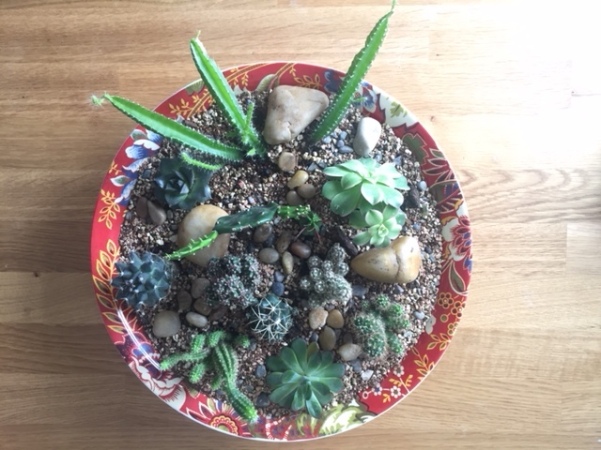
I think I’ve fully embraced my obsession with plants recently when I asked for a clipping of a beautiful vine during a stop at my favourite coffee shop in Toronto’s west end. I visit Field Trip Cafe almost every weekday morning after a boxing class, and their Americanos are the best in the city. But the Americanos aren’t cheap, so I feel like I’m helping them invest in their plant collection. In that sense, I saw no harm in asking the barista if I could take a clipping of the vine for propagation purposes. My coffee partner was amused as I navigated through the packed cafe with a pair of scissors in hand and determination to take home the plant I had been eyeing for weeks.
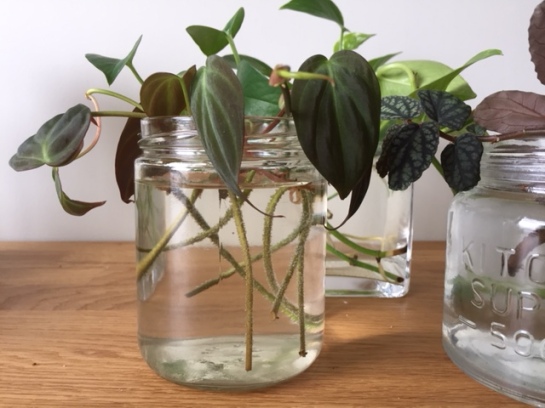
Success! But I haven’t been able to identify this vine plant so far.
I’ve decided to re-start this blog again and dedicate it to horticulture because I can’t seem to find good blogs or websites about plants that aren’t outdated, poorly designed, or difficult to read. I’m still learning but come join me in my adventures. Please note that I was unable to find my camera charger, so photos are courtesy of a well-abused iPhone 6 (sorry!).
Propagation + Plants
I’ve killed a lot of plants over the years (RIP every string of pearls plant I’ve owned). In their memory, I’ve been learning how to propagate succulents and other indoor plants since January, mostly because I’m curious but also because I don’t want to keep purchasing plants when I can grow my own.
My current propagation adventure has been a rebellious move considering that succulents are dormant in winter. However, I want to share my current attempts and welcome feedback on how to propagate succulents during a winter that seems to never end.
Potted Plants
The pothos plant is one of the easiest indoor plants to keep and propagate. I’ve had my pothos plant for two years, and it grows like a weed with minimal care. I’ve propagated many pothos cuttings for friends. It seems to take 2-3 months for their roots to grow big enough to transplant into soil. Here’s a recently pothos cutting that has been sitting in water for 5-6 weeks.
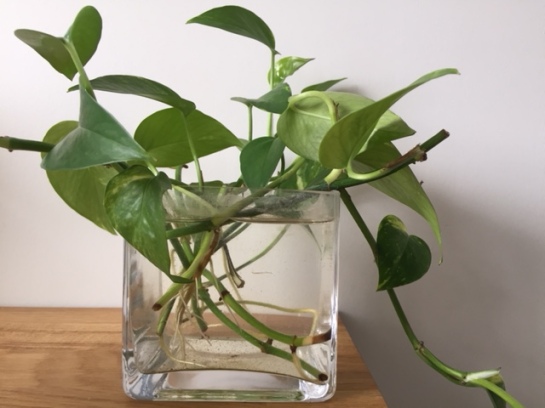 Some of the clippings are newer, so their roots haven’t formed yet. I have floor-to-ceiling windows so the plants receive a lot of light but it is north-facing.
Some of the clippings are newer, so their roots haven’t formed yet. I have floor-to-ceiling windows so the plants receive a lot of light but it is north-facing.
Along with the pothos, the Field Trip Cafe vine, I’ve also propagated this beautiful vine. It’s another one that I haven’t been able to identify. I wasn’t sure if it would grow in water (I tried to propagate a bird fern in water, but it wouldn’t grow roots). This vine seems to be doing well but growing roots at a slower pace than the pothos cutting. It also sits in north-facing light.
Succulents
I’ve been experimenting to learn how to propagate succulents. Previously, I scoured many Pinterest articles, watched plenty of YouTube videos, and consulted with my plant people (yes, I have plant experts in my life because that’s how you roll when you live on Dundas West and, like for the record, we’re talking about West Dundas West that only begins at Ossington, not Bathurst, okay). But I’ve had little success in finding information so I’m trying things my way.
Okay, so maybe the above is a bit excessive or too eager. These are four different types of succulent plants, starting from the furthest away: jade (crassular ovata), hens and chick (sempervivum tectorum), and echerveria. If you’re like, Rose, that’s cool, but can you tell me the specific names of the hens and chicks and echerveria? Sorry, I honestly tried to find the names but it’s a deep, dark interweb out there and I don’t have time to dig for information. If someone could create a plant app that’s similar to Shazam, then I would sleep better at night, k?
Anyway, I’ve twisted the leaves from the stems of the plants, making sure to carefully twist at the base. If incorrectly twisted, the leaf cutting will probably rot and die instead of growing roots. Like this little guy is starting to do (*sad face emoji*).
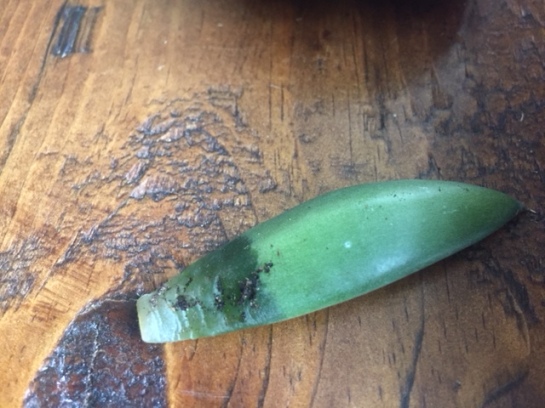
Once separated from the stem, I let the cuttings dry on a tray or sheet of paper so that they callus at the end. I lost a beautiful aloe that I had inherited from a friend’s vintage store because I didn’t believe the aloe needed to callus. If you place the fresh leaf cuttings on soil, they will rot because they’re too moist.
Once callused, I sometimes dip the cuttings into rooting powder but I haven’t seen a difference in doing so. Half of my current leaf cuttings have rooting powder and the other half do not. Let’s see what happens.
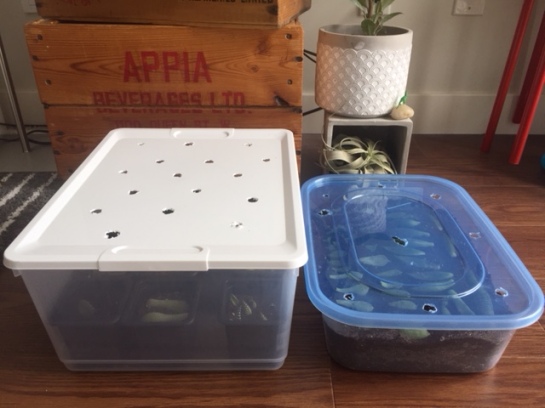 Referring back to the experimental propagating process, I’ve created mini greenhouses to see if the warm, moist air will help the cuttings grow faster. I’ve placed the leaf cuttings on a mixture of cacti/succulent soil and normal indoor plant soil.
Referring back to the experimental propagating process, I’ve created mini greenhouses to see if the warm, moist air will help the cuttings grow faster. I’ve placed the leaf cuttings on a mixture of cacti/succulent soil and normal indoor plant soil.
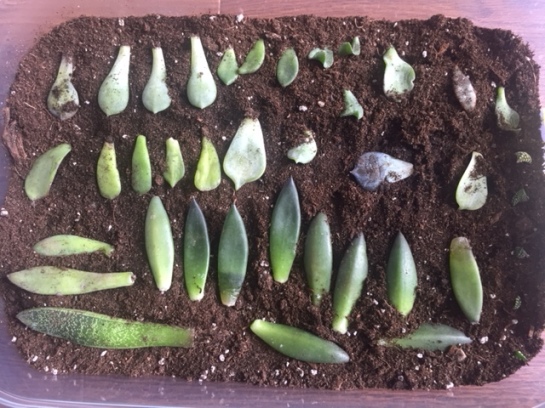
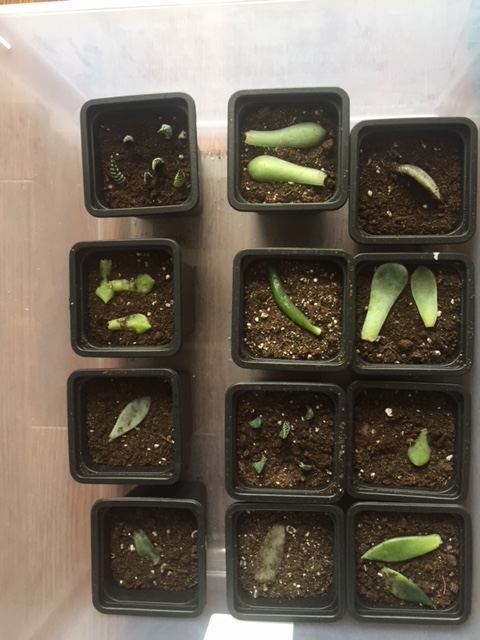
Theses include different types of succulents, such as a gollum jade, zebra plant (haworthia fasciata), panda plant (kalanchoe tomentosa), a variegated aloe, and one giant cutting of a little warty gasteria.
Some of these guys have been dormant since January but they haven’t shrivelled and die, so I still have hope that they will grow roots. The echeveria (second from the left) just started growing roots in two weeks. Promising.
But the little warty gasteria in my hand has been an ordeal. I plucked it in January. It was dormant. Then it started to grow roots, then stopped, then started to grow again when I put it in the mini greenhouse and now has appeared to stop again.
This little hen-and-chick is the teacher’s pet because it’s sprouting new leaves. Good lil fella – A+ in my books.
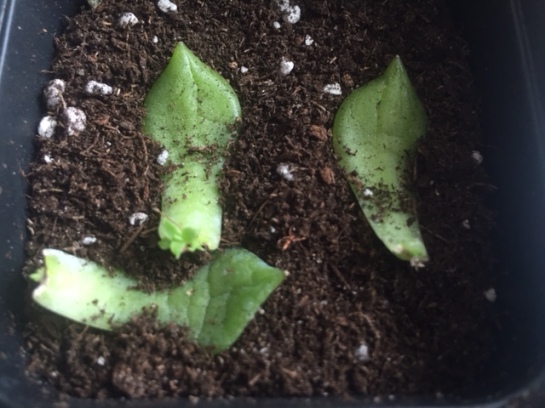
I spray the leaf cuttings every few days. You can see in the white container that there are few that have died, probably from too much moisture (you can tell the leaf is too moist because it’s rotten and will almost burst like a water balloon when you squeeze it). Although this is indoors, I think the weather influences their growth so I have to be more aware of when it’s sunny or overcast. I’ve recently indulged in bad behaviour by spraying the plants in the morning before sunrise because that’s how early my morning boxing classes are. Clearly, watering plants in the morning during winter is not a good idea because the lack of sun traps moisture.
Additionally, there’s no waste in leaf propagation: you can keep the stems for the plants that you pluck, because they will grow back leaves. It’s a win-win situation, so thank you Mother Nature.
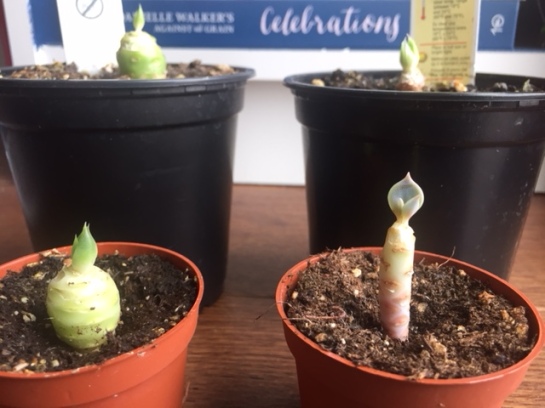
So, in summary, my succulent propagation involves the following steps: twist leaves, allow to callus, place on top of proper soil mixture, put in greenhouse during winter, and sing them lullabies to enable growth (before switching to punching the life out of my partner and/or boxing bag. I strive for balance, duh).
And, because I love to sing and dance while watering my plants, here’s my current favourite album to listen to while horticulture-ing:
Courtney Marie Andrews – May Your Kindness Remain








